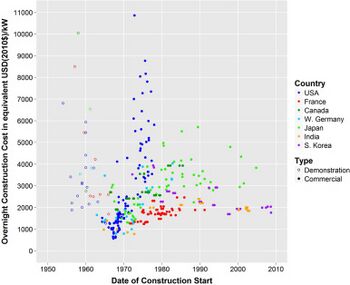Cost of nuclear power: Difference between revisions
Jump to navigation
Jump to search
(→Cost of alternatives: add wind turbines) |
(→Hydrogen:: cost of hydrogen) |
||
| Line 18: | Line 18: | ||
Li-ion:<br> | Li-ion:<br> | ||
===Hydrogen:=== | ===Hydrogen:=== | ||
$2 per kg promised by mid 2020s<ref>[https://www.pv-magazine-australia.com/2022/08/02/game-changing-electrolysis-technology-from-nsw-closes-42m-funding-round-oversubscribed/ Australian company Hysata, PV Magazine, Aug 2022.]</ref><br> | |||
$1 per kg ten-year goal set by DOE<ref>[https://www.energy.gov/eere/articles/five-things-you-might-not-know-about-hydrogen-shot DOE's "Hydrogen Shot"]</ref><br> | |||
$0.12 per kWh electrical energy storage cost, assuming $2 per kg of H2, and 50% overall efficiency<br> | |||
== Notes and References == | == Notes and References == | ||
{{Reflist}} | {{Reflist}} | ||
Revision as of 09:31, 21 August 2022
Historical Costs
see Fig.1
Cost of new designs
ThorCon MSR:
$1200 per kW + $0.03 per kWh
Cost of alternatives
Rooftop Solar (no batteries):
$2,900 per kW (nameplate), $11,600 per kW avg (25% Capacity Factor)
Wind Turbines
$770–$850 per kW (nameplate), down from $1800 in 2008.[2]
$3240 per kW avg (25% Capacity Factor)
Batteries:
Lead-Acid: $300 per kWh
Li-ion:
Hydrogen:
$2 per kg promised by mid 2020s[3]
$1 per kg ten-year goal set by DOE[4]
$0.12 per kWh electrical energy storage cost, assuming $2 per kg of H2, and 50% overall efficiency
Notes and References
- ↑ Fig.12 in Lovering 2016 "Historical construction costs of global nuclear power reactors" https://doi.org/10.1016/j.enpol.2016.01.011
- ↑ DOE report 30 Aug 2021
- ↑ Australian company Hysata, PV Magazine, Aug 2022.
- ↑ DOE's "Hydrogen Shot"
